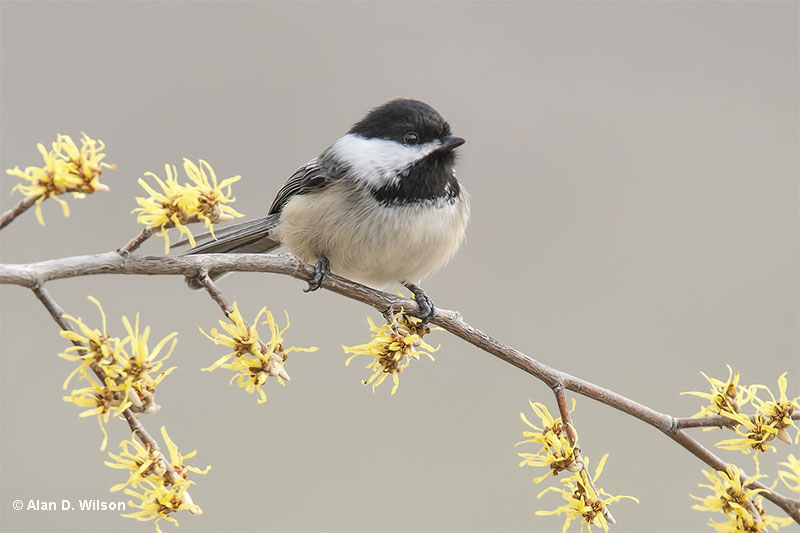
One of the biggest and wildest states in the north, Minnesota is an exciting destination for birders!
The list for the birds of Minnesota includes 443 species living in 86,935.83 square miles of forest, lakes, rivers, wetlands, farms, and prairies.
In summer, we can see rare beauties like the Golden-winged Warbler and Connecticut Warbler. In winter, cold weather brings Snowy Owl, Great Gray Owl, and other choice species to the birding scene!
Although some grassland birds have declined, Minnesota still offers plenty of habitat for hundreds of birds.
We bet you have seen a bunch of the birds of Minnesota but how many could you identify?
Get help with our up-to-date list of common backyard and wild birds in Minnesota!
On this page
- Most Common Birds Of Minnesota
- Black-capped Chickadee
- American Crow
- Blue Jay
- Downy Woodpecker
- American Robin
- American Goldfinch
- White-breasted Nuthatch
- Northern Cardinal
- Mallard
- Canada Goose
- Red-winged Blackbird
- Red-bellied Woodpecker
- Hairy Woodpecker
- Dark-eyed Junco
- Song Sparrow
- House Finch
- House Sparrow
- Mourning Dove
- Bald Eagle
- Common Grackle
- Gray Catbird
- Ring-billed Gull
- European Starling
- Wood Duck
- Common Yellowthroat
- Cedar Waxwing
- Northern Flicker
- Red-breasted Nuthatch
- Trumpeter Swan
- Chipping Sparrow
- House Wren
- Pileated Woodpecker
- White-throated Sparrow
- Barn Swallow
- Great Blue Heron
- Birds of Minnesota – Frequently Asked Questions
Most Common Birds Of Minnesota
A lot of interesting birds live in Minnesota, it can be hard to know which species to expect. To create the best, up-to-date list of the most commonly seen birds, we used eBird sightings to arrange bird species from most common to least common.
To help identify them, we also included key information about their appearance and behavior.
According to the latest bird sightings in Minnesota on eBird, the following species are the most commonly observed birds in the state.
PS! Keep in mind that the birds at the bottom of this list are common birds too!
Black-capped Chickadee
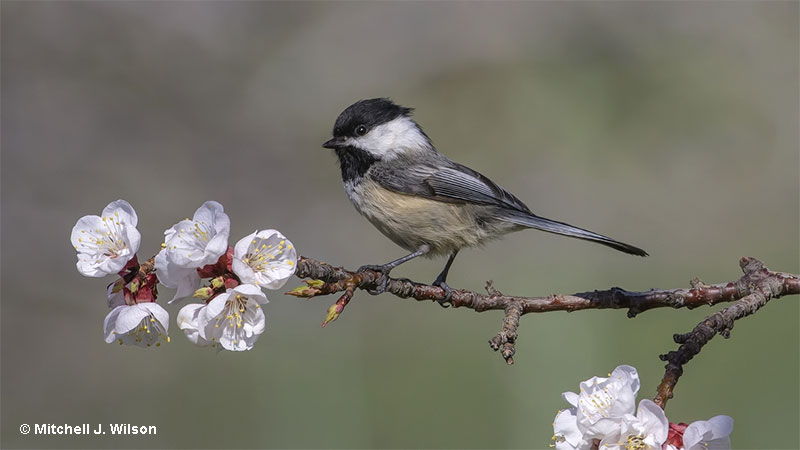
© Mitchell J. Wilson
Scientific name: Poecile atricapilla
Length: 5.25 inches
Weight: .39 ounces
Wingspan: 8 inches
Song: “see bee, see bee”
Black-capped Chickadees are small grayish birds with a black cap, black throat, and a stubby black beak. Both sexes look alike and have a white face, white edging to the feathers in their wings, and some buff on their underparts.
These cute little birds feed on caterpillars, insects, spiders, seeds, and fruit. They are regular visitors to feeders but also forage on bark, twigs, and in foliage. When foraging, they often hang upside down from twigs and usually occur in small flocks.
This species makes a small, soft nest out of moss and deer hair. It builds its nest in tree cavities and can also use nest boxes.
Black-capped Chickadees live in a variety of wooded habitats and can also occur in gardens. They are year-round residents in parts of Alaska, Canada, and the northern USA south to Oregon, northern New Mexico, northern Ohio, all the way to North Carolina.
Key Identifications:
- Small, cute, grayish birds with a black cap, white face, and a black throat.
- Forages for insects, spiders, seeds, and fruit in wooded habitats. Also visits feeders.
- Nests in tree cavities and nest boxes.
- This little bird is quite vocal and often says its name, “chick-a-deedeedeedeedee”. They also make other chattering calls and sing a whistled song, “see bee, see bee”.
The Black-capped Chickadee is a small, acrobatic bird with a black cap, white face, and a black throat. They usually forage in flocks with other chickadees and other small birds, and often visit feeders. This species hides dozens of seeds and other bits of food for the winter, and recalls where each of these food items are hidden.
American Crow
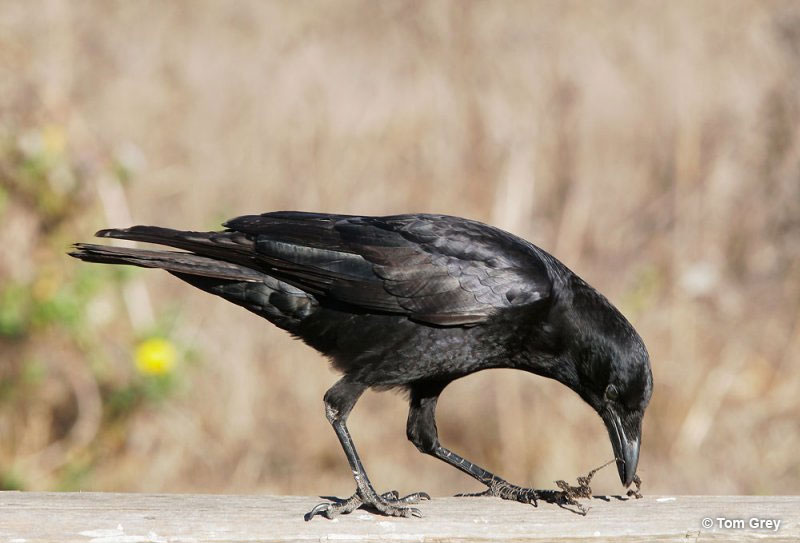
© Tom Grey
Scientific name: Corvus brachyrhynchos
Length: 17.5 inches
Weight: 1 pound
Wingspan: 39 inches
Song: “Caw! Caw!”
The American Crow is a big, all black bird with a strong, stout bill. In certain lighting, it can have metallic purple and blue iridescence.
Both sexes look the same and have some feathering on their beaks, long, broad wings, and a broad tail.
American Crows have direct flight with strong, steady wing beats. Crows are very social and intelligent birds that are usually seen in flocks. They forage together on the ground or in trees and eat just about anything they can find.
Related: 8 hawks you can see in Minnesota
Some of their more regular foods include carrion, fruit, nuts, seeds, insects, and small animals. Like most jays and crow species, they also eat the eggs and nestlings of other bird species.
This species builds bulky stick nests high in trees and lives in most habitats except for high mountains and arid zones.
The American Crow occurs in southern Alaska and much of Canada and the USA.
Key Identifications:
- Big, all black bird with long, broad wing and a broad tail.
- Forages for carrion, fruit, seeds, insects, and small animals.
- Builds a bulky stick nest high in a tree.
- American Crows are very vocal birds. They can make several calls but their most common one is, “Caw! Caw! Caw!”.
The American Crow is a common, large black bird that frequently calls, “Caw! Caw! Caw!”. It usually occurs in flocks and lives in all sorts of places, even urban zones. These birds are very smart and have funerals or wakes! When a crow dies, other crows mark the occasion by gathering together and loudly calling.
Blue Jay
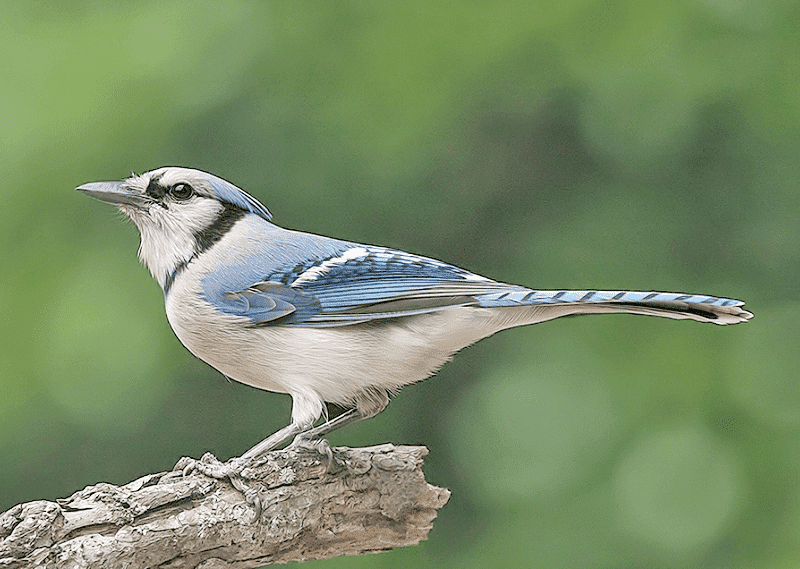
Photograph © Alan Wilson.
Scientific name: Cyanocitta cristata
Length: 11 inches
Weight: 3 ounces
Wingspan: 16 inches
Song: “Nyeah! Nyeah! Nyeah!”
The Blue Jay is a fairly large, crested bird with a straight black bill. Both sexes look alike and are blue above and gray and white below. They also have some small black lines on their faces and a narrow black necklace that goes up to the side of their face and crest.
Blue Jays also have some white markings and black barring in their wings and on their tail. Young birds look like adults but are duller blue.
They make messy cup nests at various heights in a variety of trees.
These social and intelligent birds feed on acorns, nuts, insects, and other small creatures. Like other members of the jay and crow family, they eat the eggs and nestlings of other birds.
The Blue Jay is a common bird of woodlands, forest, and towns east of the Rocky Mountains in the USA and central and southern Canada.
Key Identifications:
- Crested, fairly large bird with bright blue above and gray below.
- Feeds in trees and at feeders. Eats acorns, nuts, insects and many other food items.
- Makes a messy cup nest of sticks in a tree.
- Very vocal. In flight, Blue Jays often call as they swoop through the trees. They make a variety of sounds and mimic some other birds. Common calls include a nasal and complaining “Nyeah! Nyeah! Nyeah!” and various whistled calls.
The Blue Jay is a common, intelligent, and noisy bird. They make their presence known with their loud calls and can visit feeders. Ironically, when communicating with each other at close quarters, this species makes much softer and quieter calls. It’s almost as if they are talking with each other!
Downy Woodpecker
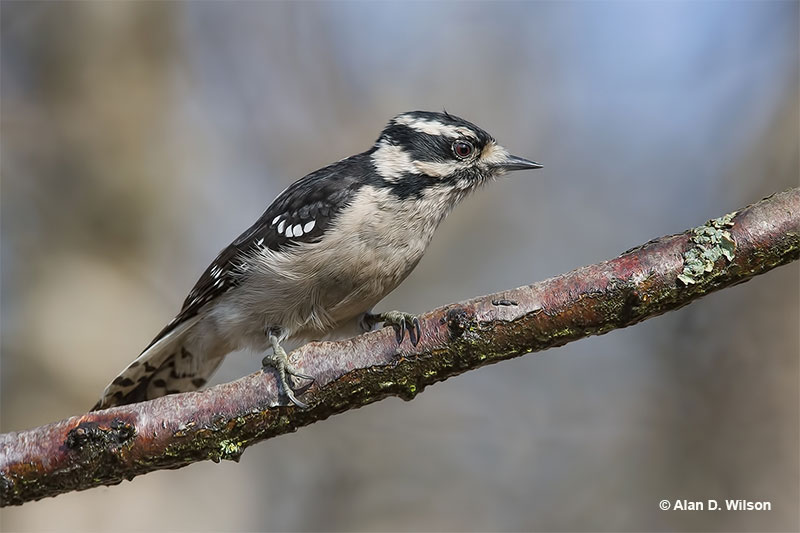
© Alan D. Wilson
Scientific name: Dryobates pubescens
Length: 6.75 inches
Weight: .95 ounces
Wingspan: 12 inches
Song: “Pik! Ch,ch,ch,ch,ch,ch,ch!”
The Downy Woodpecker is a small black and white woodpecker with a short, black beak. They are patterned black and white above and have white backs and white underparts. Both sexes look alike except that males have a small, bright red patch on the top back part of their head.
Young birds look like adults but have a reddish patch on the top of their head. Downy Woodpeckers also have a few small black marks in their white outer tail feathers, and a small white tuft at the base of their beak.
This woodpecker eats insects, other small creatures, seeds, and small fruits. It pecks into live and dead wood and often forages on smaller branches and twigs. These friendly little woodpeckers are also common feeder birds.
They nest in tree cavities and live in gardens and a wide variety of woodlands. We see Downy Woodpeckers in much of Canada and the USA, but not in arid habitats.
Key Identifications:
- Smallest woodpecker in North America. Mostly black and white with a short, black beak.
- Forages on trees, in bushes, and at feeders for insects, seeds, and suet.
- Nests in tree cavities.
- The Downy Woodpecker makes sharp “pik!” calls and also has a trilled call, “Ch,ch,ch,ch,ch,ch,ch!“.
Downy Woodpeckers are the smallest woodpecker species in North America and usually occur in pairs. They can also forage with other small birds and often visit feeders. This species takes advantage of its size to peck into the stems of weeds and other plants too small for larger woodpeckers to perch on.
American Robin

© Tom Grey
Scientific name: Turdus migratorius
Length: 10 inches
Weight: 2.7 ounces
Wingspan: 17 inches
Song: “cheery, cheery, cheery, cheery, cheer, cheer”
The American Robin is a familiar and common thrush that is dark gray above and brick red below. It also has an orange-yellow bill, a blackish head with white markings around the eyes and on the throat, and a white belly.
Both sexes of this thrush species are similar but males are darker above and more reddish on the underparts. Young American Robins have more white marks on their faces and spotting on orange underparts.
In flight, this common thrush in Minnesota also shows white corners in its outer tail feathers.
American Robins forage on the ground for worms, insects, snails, and other small creatures. In winter, these common birds flock together and perch in trees and bushes to eat berries and fruit.
The American Robin makes a cup nest in trees and lives in parks, woodlands, towns, and many other habitats. They reside in Alaska, most of Canada, the USA (including Minnesota), and in Mexico.
Key Identifications:
- Fair-sized songbird that is dark gray above, and brick red and white below.
- Forages for worms and bugs on lawns and other open grassy areas, also flocks together to feed on fruiting trees in the winter.
- Makes a cup nest in trees.
- The American Robin is quite vocal and makes a loud, sharp, “yenk!” call and quieter “check,check,check” calls. It also has a lovely cheerful song of caroled phrases, “cheery, cheery, cheery, cheery, cheer, cheer”.
The American Robin is a common, handsome thrush with dark gray upperparts and brick red and white underparts. Populations of the American Robin have been estimated at 370,000,000, which makes them the most numerous landbirds of North America.
American Goldfinch
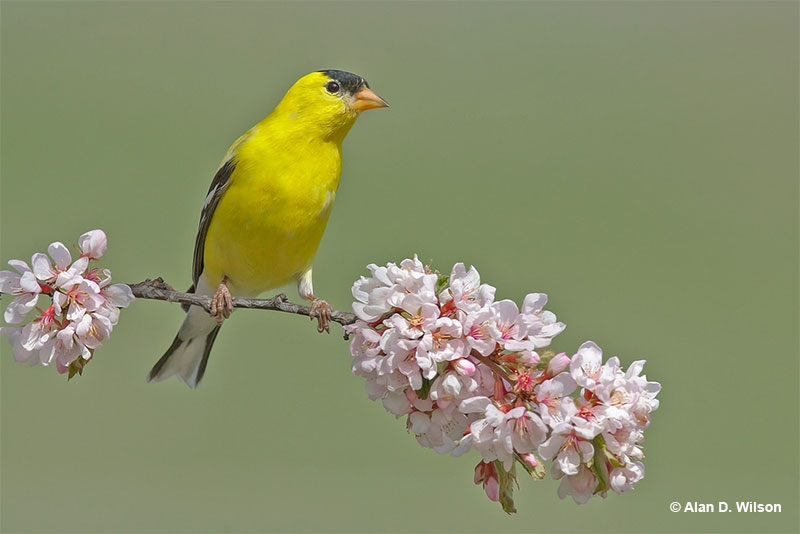
© Alan D. Wilson
Scientific name: Spinus tristis
Length: 4.3 to 5.1 inches
Weight: 0.4 to 0.7 ounces
Wingspan: 7.5 to 8.7 inches
Song: “po-ta-to-chip”
Adult male American Goldfinches have black foreheads, black wings with white markings, white patches both above and below the tail, and are bright yellow overall in the spring and early summer. Female American Goldfinches are paler yellow underneath and olive above. In the winter, both males and females are unstreaked brown, drab, and have blackish wings with two faint wing bars.
American Goldfinches inhabit overgrown areas like open floodplains and weedy fields, especially thistle, aster, and sunflower plants. They feed off of these plants and use trees and shrubs for nesting. It’s not uncommon to see these birds in backyards, parks, and suburbs as well.
American Goldfinches primarily consume seeds; it’s rare to see them consume anything else. The main types of seeds they eat include thistle, sunflower, grass seeds, and asters.
Key Identifications:
- Male birds have black foreheads, black wings with white markings, white patches both above and below the tail, and are bright yellow overall in the spring and early summer.
- Male and Female American Goldfinch look similar. Females are paler yellow underneath and olive above. Both males and females look the same in the winter.
- These birds are smaller than Tufted Titmice.
- The Eastern Goldfinch is a small species of finch. They have short, notched tails, short, conical bills, long wings, and a small head.
Eastern Goldfinches are very acrobatic and active birds. You can commonly see them balancing on thistle seedheads, dandelions, and other plants to pick seeds. To encourage these finches to visit your yard, it’s highly recommended that you plant native composite plants like thistles and milkweed.
White-breasted Nuthatch
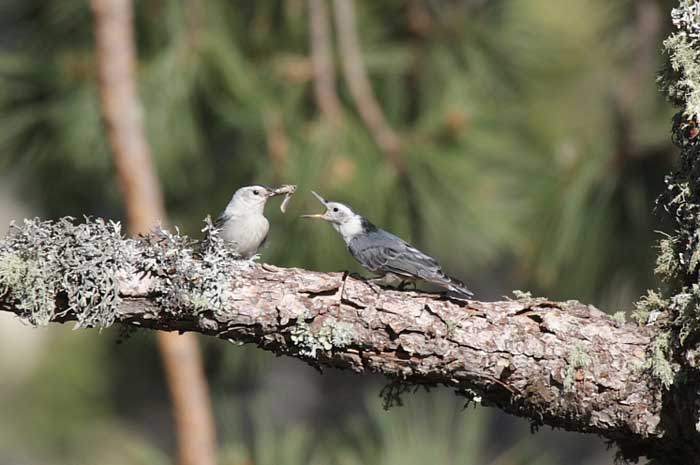
Scientific name: Sitta carolinensis
Length: 5.1 to 5.5 inches
Weight: 0.6 to 1.1 ounces
Wingspan: 7.9 to 10.6 inches
Song: “wha-wha-wha”
White-breasted Nuthatches have frosty white underparts and faces as well as gray-blue backs. Additionally, under the tail and the lower belly are chestnut brown, and the cap and neck are either black or gray.
White-breasted Nuthatches inhabit mature woods and are most commonly found in coniferous and deciduous forests. You can also find them in open areas with large trees and at woodland edges.
Nuthatches primarily consume insects. Some of the prey they consume include tree hoppers, beetles, weevil larvae, ants, wood-boring beetle larvae, and caterpillars. They also eat nuts and seeds like sunflower seeds and acorns.
Key Identifications:
- White-breasted Nuthatches are smaller than a Tufted Titmouse.
- White-breasted Nuthatches have frosty white underparts and faces and gray-blue backs.
- These birds have large heads, almost no necks, narrow, straight bills, and very short tails.
- White-breasted Nuthatches can be easily identified by their habit of sneaking up and down tree trunks.
White-breasted Nuthatches are widespread, agile little birds. They visit bird feeders and will readily consume mealworms and meaty, large seeds. White-breasted Nuthatches are known as the “upside down” bird. This is because it’s not uncommon to see them creeping headfirst down the trunk of a tree in search of insects.
Northern Cardinal
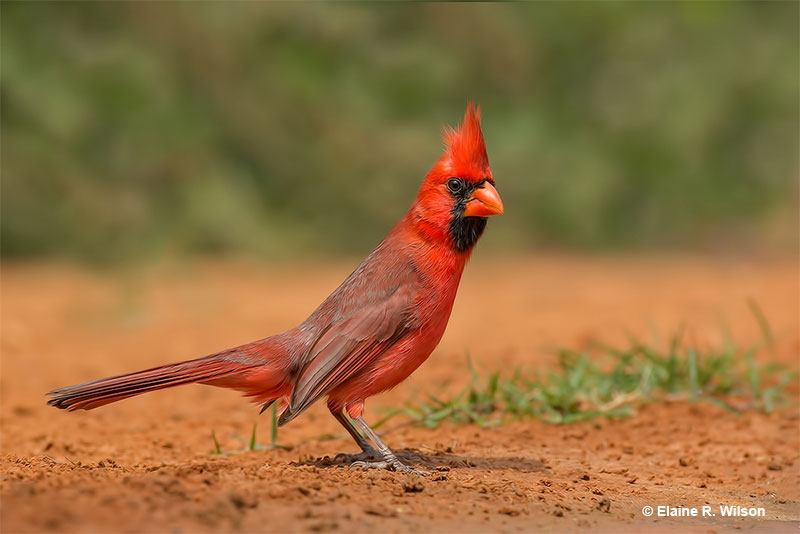
© Elaine R. Wilson
Scientific name: Cardinalis cardinalis
Length: 8.75 inches
Weight: 1.6 ounces
Wingspan: 12 inches
Song: “pichew-pichew-pichew, chew,chew,chew,chew,chew”
Northern Cardinals are medium-sized songbirds with a perky crest and big orange-red beak. Males are bright red with a black throat and face, and have dusky red on their back, wings, and tail.
Female Northern Cardinals are grayish-brown and buff with some black on their face and throat. They also have red highlights in their crest, wings, and long, rounded tail.
This species has short, rounded wings and seems to bounce up and down as they move through the air. In flight, Northern Cardinals also make sharp chip notes.
The Northern Cardinal is a bird of second growth, gardens, and parks. It eats seeds, insects, and some fruit and is a regular visitor to bird feeders. They forage on and near the ground but males sing from a prominent perch.
This beautiful bird occurs in pairs and nests in bushes and low trees. It is common in the eastern and southwestern USA, southern Ontario, and in Mexico.
Key Identifications:
- Crested bird with a conical orange-red beak and a black face. Males are red, females are grayish-brown and buff.
- Forages for seeds and insects on and near the ground.
- Makes a cup-shaped nest in bushes and low trees.
- Sings a clear, whistled song of repeated notes. They can sound like “cheer, cheer, chew, chew, chew, chew” or a quick “birdee,birdee,birdee,birdee,birdee“. They also make loud, sharp chip notes.
Northern Cardinals are one of the most beautiful common birds in most states, including Minnesota. It’s no wonder seven different states chose it to be their official bird. Another fun fact about this species is that female Northern Cardinals also sing. They sing while sitting on the nest and may do so to tell their mates to bring food or warn them about predators.
Mallard
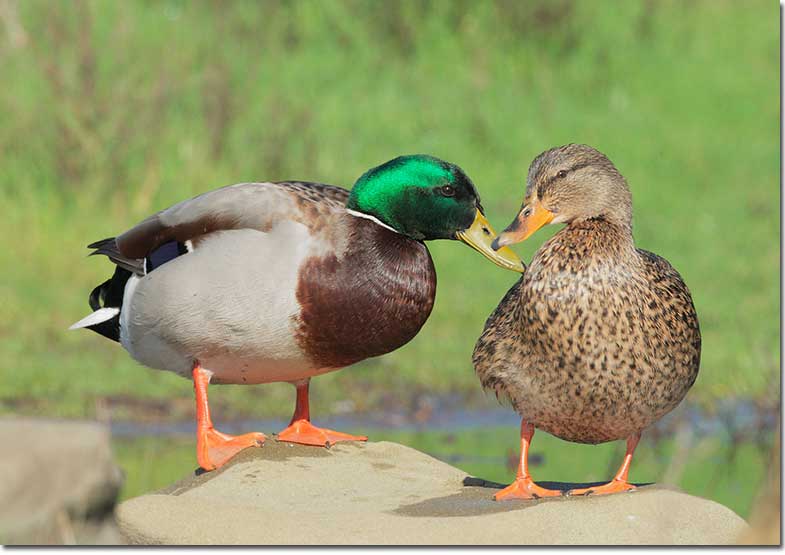
Mallard pair
Scientific name: Anas platyrhynchos
Length: 23 inches
Weight: 2.4 pounds
Wingspan: 35 inches
Song: “quack, quack”
The Mallard is a fairly large, familiar duck. The male has a metallic green head, yellow bill, narrow white ring around the neck, and chestnut breast. The rest of the bird is pale gray with pale brown, and black on its back and around his tail.
Female Mallards are mottled brown and buff with a dark crown and line through the eyes, and have a dark gray and orange beak.
In flight, both sexes show a green-blue wing patch bordered with white.
Mallards eat a variety of items including insect larvae, snails, other small aquatic creatures, acorns, seeds, and grain. They forage by filtering and picking up food items in and near shallow water, and in farm fields.
This duck species makes a shallow nest with sticks and lined with down feathers. It builds its nest on the ground, hidden in grass or under a bush.
The Mallard lives in ponds, marshes, and many wetland habitats in Canada, USA, and Eurasia.
Key Identifications:
- Large and familiar duck, male has dark green head, white ring around the neck, and a chestnut breast. Female is mottled buff and brown, and has a dark gray and orange beak.
- Feeds on insect larvae, grain, seeds, and other items picked up with its bill in and near shallow water.
- Makes a shallow stick nest hidden in grass or under a bush.
- The female Mallard makes the classic “quack, quack” duck sound. Males make similar but softer sounds and a whistling call.
The Mallard is a fairly large and familiar duck with a dark green head (the male), or is buff and brown with a dark gray and orange beak (the female). Thus duck species often lives near people and occurs on lakes, ponds, and other wetlands. No matter how different they look, most small domestic duck species are descended from wild Mallards.
See more: Common duck species in Minnesota
Canada Goose
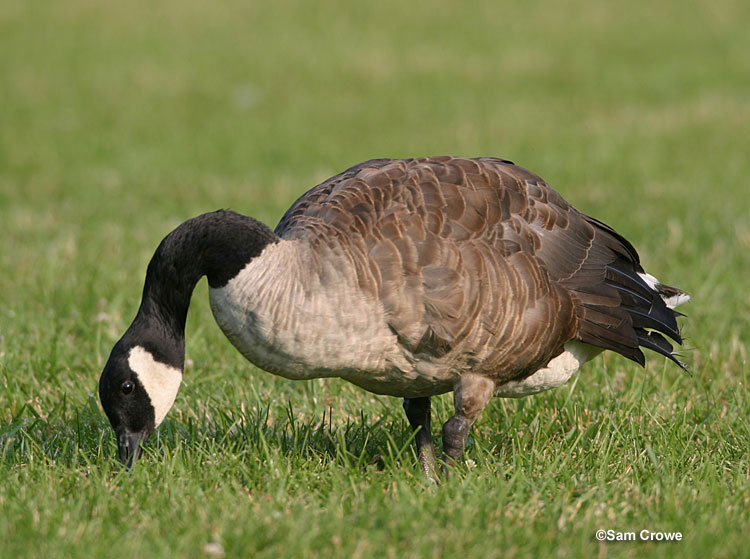
Scientific name: Branta canadensis
Length: 29.9 to 43.3 inches
Weight: 105.8 to 317.5 ounces
Wingspan: 50 to 66.9 inches
Song: Canada Geese don’t have a song, but they do produce a variety of calls, including loud honks, hisses, cackles, and barks.
Canada Geese have white cheeks, black heads, white chinstraps, black necks, brown backs, and tan breasts.
Canada Geese live in many different habitats near grain fields, grassy fields, and water. These waterbirds are particularly drawn to lawns because when they’re caring for their young, manicured lawns give them an unobstructed, broad view of any approaching predators, and they can digest grass.
In the spring and summer months, geese concentrate on consuming sedges and grasses, including eelgrass and skunk cabbage leaves. During the fall and winter months, they rely more on seeds and berries, including berries and agricultural grains.
Key Identifications:
- Look for their white cheeks, white chinstraps, black heads, black necks, brown backs, and tan breasts.
- Male and Female Canadian Geese look identical. The best ways to differentiate the two is by looking at size and behavior.
- Canada Geese are larger than a Mallard.
- Canada Geese are large waterbirds. They have long necks, large bodies, wide, flat bills, and big webbed feet.
Thousands of Canada Geese migrate south and north every year. They’re easily recognizable with their long V-shaped formations. However, more and more of these birds are staying put in suburban and urban areas year-round, due to lawn maintenance.
Red-winged Blackbird
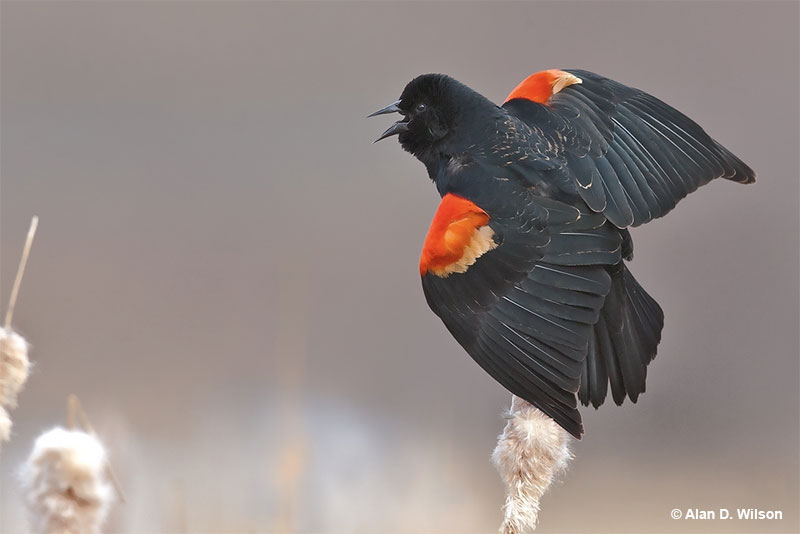
Scientific name: Agelaius phoeniceus
Length: 8.75 inches
Weight: 1.8 ounces
Wingspan: 13 inches
Song: “kan-keree!”
The Red-winged Blackbird is a medium-sized blackbird species with a sharp, all black bill. Males also have a scarlet patch with a pale yellow border on the shoulder of each wing.
Female Red-winged Blackbirds are dark, heavily streaked, brownish-gray birds with an orange-buff eyebrow and throat. She can also have a little bit of dingy red on her shoulder.
Red-winged Blackbirds often flock together and can form very large groups in the winter. They feed on seeds, grain, and insects found on lawns, in marshes, farm fields, and other open habitats.
This species builds a cup nest made of leaves and dead stems in a bush or other low vegetation in a marsh, park, or brushy field.
Red-winged Blackbirds are very common birds that live in all sorts of open habitats. We see them in parks, farming areas, and marshes in much of Canada, the USA, Mexico, and parts of the Central America.
Key Identifications:
- Males are medium-sized blackbirds with a bright red patch on their wings. Females are heavily streaked, have a sharp black beak, and buff on the head.
- Feeds on seeds, grain, and insects on the ground in many open habitats.
- Builds a cup nest in a bush or other low vegetation.
- Red-winged Blackbirds often call. Males sing a loud, “kan-keree!” and both sexes also make “check!” calls and a high-pitched whistle-like sound.
The Red-winged Blackbird is a common, social species easily seen in marshes and open habitats. In the winter, it can form huge flocks that feed in farm fields. This species can make a daily commute of 50 miles to and from roosting and feeding sites.
Red-bellied Woodpecker
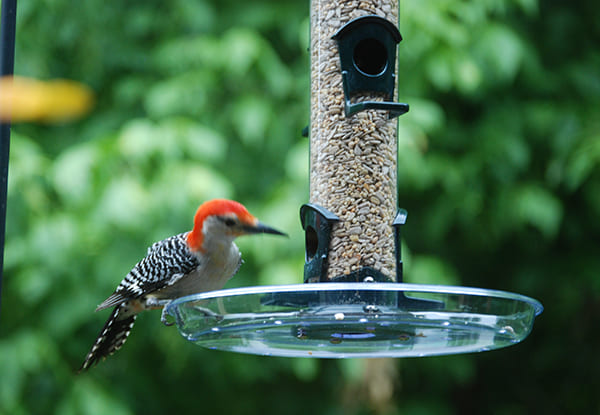
Scientific name: Melanerpes carolinus
Length: 9.25 inches
Weight: 2.2 ounces
Wingspan: 16 inches
Song: “Qwerr!”
Red-bellied Woodpeckers are medium-sized with black and white barring on their back and wings. They have a long beak and pale gray underparts with a small red patch on the belly.
Males have red on the head from the bill to the back of the neck (the nape). Females have an orange-red spot above their bill and red on the back of their head. Both sexes have a mostly white rump and central tail feathers.
This woodpecker species has long wings and “undulating” flight where it moves up and down as it flies. In flight, Red-bellied Woodpeckers show a small white patch in their wings.
The Red-bellied Woodpecker lives in wooded habitats. It eats nuts, seeds, insects, fruit, and can attack nestlings of other species. It also visits bird feeders.
This striking woodpecker occurs in pairs and nests in tree cavities high above the ground. It is common in the eastern USA and parts of southern Ontario.
Key Identifications:
- Grayish woodpecker with black and white barring above, and red on the top of the head and back of the neck.
- Forages for seeds, nuts, insects and other food on trunks and branches.
- Nests in a tree cavity, high overhead.
- Makes a loud exclamation, “Qwerr!“. It also makes other, briefer and quieter “chug” calls.
Red-bellied Woodpeckers are common and adaptable birds. As long as big trees are present, we see them in urban areas as well as wilder places. They also visit feeders and have a very long tongue. When extended, it sticks out 2 inches past the tip of its bill!
Hairy Woodpecker
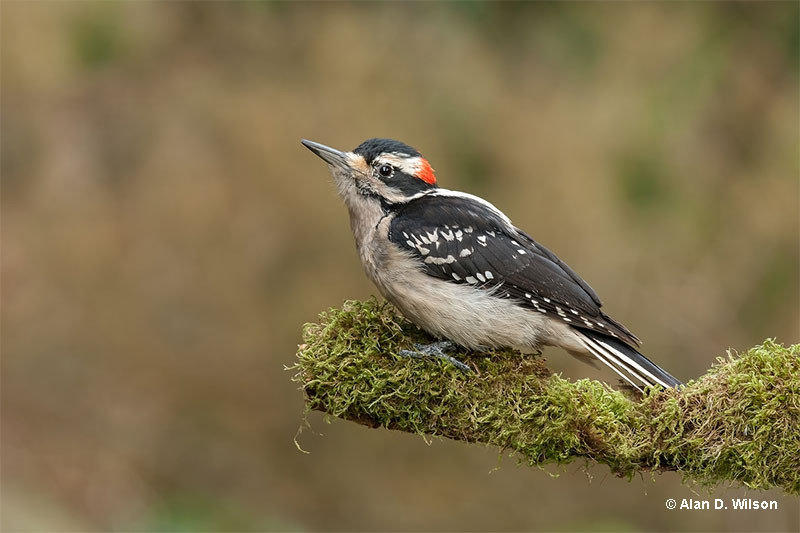
© Alan D. Wilson
Scientific name: Dryobates villosus
Length: 9.25 inches
Weight: 2.3 ounces
Wingspan: 15 inches
Song: “Qquechichichichichichicchichic!”
Hairy Woodpeckers are medium-sized, black and white woodpeckers with long, straight beaks. They have a white patch on their back and a black and white tail with unmarked, white outer tail feathers.
Both sexes look very similar but males have a small, bright red spot on the back of their head. Young birds have a dull red patch on top of their heads.
This woodpecker species feeds on insects, other small creatures, and a variety of seeds and fruit. They forage by pecking into bark and picking berries and other fruit from branches. In areas with big, mature trees, Hairy Woodpeckers are also regular visitors to bird feeders.
The Hairy Woodpecker nests in tree cavities. This species lives in parks and woodlands with mature trees in Alaska, much of Canada, and in most of the USA.
Key Identifications:
- Medium-sized, black and white woodpecker with a long straight beak and unmarked, white outer tail feathers.
- Picks insects and fruit from bark of big trees, also eats seeds at feeders.
- Nests in tree cavities.
- Often calls and gives a sharp and explosive, “Peek!” and a longer rattle, “Qquechichichichichichicchichic!”.
Hairy Woodpeckers are medium-sized, black and white woodpeckers with long, straight beaks. They need woodlands and parks with big trees and dominate the smaller Downy Woodpecker at feeders. This species gets its name from fine, hair-like feathers on its back.
Dark-eyed Junco
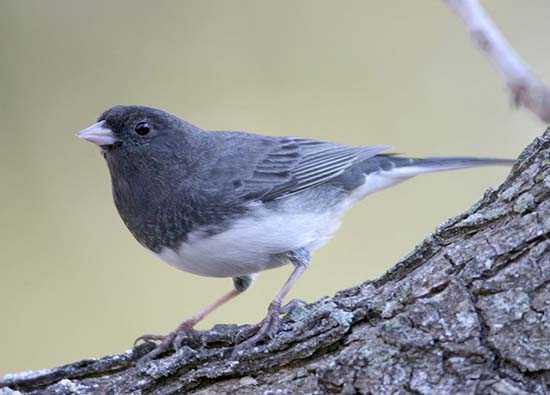
Scientific name: Junco hyemalis
Length: 6.25 inches
Weight: .67 ounces
Wingspan: 9.25 inches
Song: “sipsipsipsipsipsipsip”
Dark-eyed Juncos are sparrow-like birds with pale conical bills and dark eyes. This small bird has variable plumage with most being slate gray or gray and brown with white on their bellies, and white under their tails.
Other plumages include birds with dark masks and faint white wing bars, juncos with pale gray hoods and pinkish sides, and birds with blackish hoods and chestnut sides.
In flight, all Dark-eyed Juncos show extensive white in their longish tails.
This species feeds on seeds, insects, and some fruit and grain. Juncos forage on the ground in wooded areas, parks, and other habitats. They also feed on fallen seed beneath feeders.
They build cup nests on the ground under fallen logs, in roots, and other hidden spots. After breeding, juncos form flocks that forage together in similar wooded and semi-open habitats.
Dark-eyed Juncos are common birds in Canada, the USA, and parts of Mexico.
Key Identifications:
- Sparrow-like gray and brown bird with dark eyes, a pale beak, and white in the tail.
- Forages for seeds and insects on the ground, can feed on seeds at and beneath feeders.
- Builds a cup-shaped nest on the ground in tree roots, under logs, and other hidden places.
- This species often makes a sharp, high-pitched chip note, “pik!”. On breeding grounds, males sing a short, plain trill, “sipsipsipsipsipsipsip”.
Dark-eyed Juncos are sparrow-like, gray and brown birds with much white in the tail. Common wintering birds in many areas, they forage for seeds on the ground in wooded and park-like habitats. In many places, this common species is also known the “Snowbird” on account of only occurring in the winter months and having white on the belly and tail.
Song Sparrow
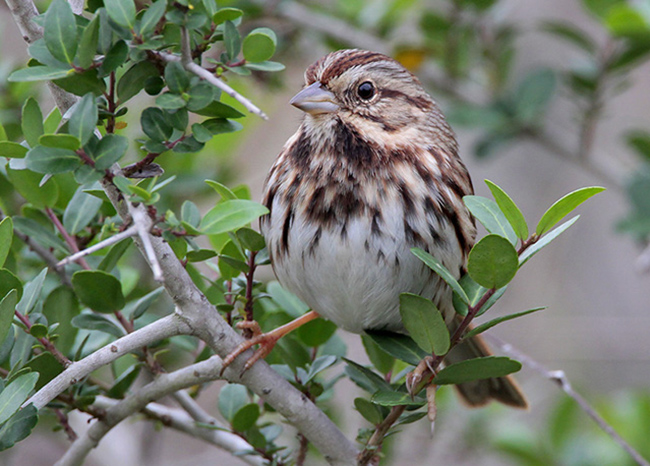
Scientific name: Melospiza melodia
Length: 4.7 to 6.7 inches
Weight: 0.4 to 1.9 ounces
Wingspan: 7.1 to 9.4 inches
Song: 2 to 6 phrases that usually start with well-spaced, abrupt notes and finishes with a trill or buzz.
Song Sparrows are small streaky brown birds that have thick streaks on their flanks and white chest. When taking a closer look at these birds, we can see that their heads are an attractive mix of slaty gray and warm red-brown. It’s important to note that these shades, as well as the amount of streaking, can vary significantly across their range in North America.
Song Sparrows are found in a wide range of open habitats, including suburbs, tidal marshes, forest edges, arctic grasslands, lake edges, desert scrub, chaparral, and aspen parklands.
In the summer, Song Sparrows consume a lot of different insects and other invertebrates. Year-round, they consume fruits and seeds. Some of the prey they consume include grasshoppers, weevils, caterpillars, craneflies, earthworms, and spiders.
Key Identifications:
- Song Sparrows are streaky brown overall and have thick streaks on their flanks and white chest.
- Their color and amount of streaking can vary significantly in Minnesota and across their range in North America.
- These birds are slightly larger than a Chipping Sparrow.
- These sparrows are fairly bulky. They have short, stout bills, somewhat rounded heads, broad wings, and long, rounded tails.
Song Sparrows are one the most familiar sparrows in North America. However, there are 24 recognized subspecies of Song Sparrows. Northern and coastal birds are streakier and darker, while desert and southern birds have duller plumages. These birds regularly visit bird feeders as long as cracked corn, sunflower seeds, or safflower is offered.
House Finch
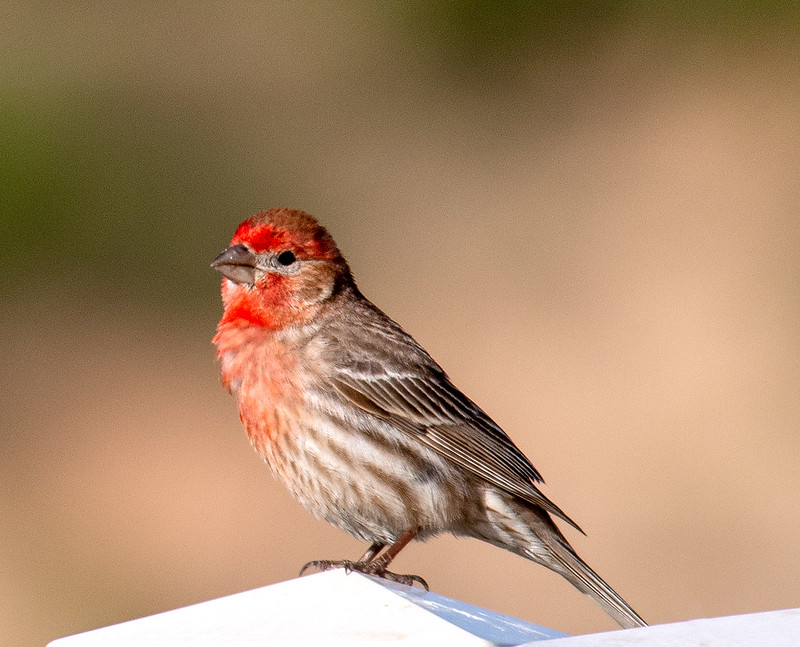
© John Hansen
Scientific name: Haemorhous mexicanus
Length: 6 inches
Weight: .88 ounces
Wingspan: 10 inches
Song: “chip,chip,chiprididip,ZREEYachip”
House Finches are sparrow-sized birds with dark, rounded beaks and fairly long wings. Males are orange-red or rose-red on their head, throat and breast, and have some red on their rump. They also have brownish streaks on their back, flanks, and white belly.
Like the male, female House Finches have two white wing bars on long, gray-brown wings. However, they lack red and are mostly streaked, dull brown-gray birds.
House Finches feed on seeds, buds, fruit, and flowers. They often visit feeders in Minnesota but also forage on the ground, and in bushes and trees.
We see these pretty birds in deserts and arid zones, and in parks, farmland, urban areas, and other semi-open habitats.
The House Finch makes a soft cup nest built on a tree, building ledge or other spot with some overhanging cover. They often occur in small groups and live in southern Canada, most of the USA, Mexico, and Hawaii.
Key Identifications:
- Reddish or plain gray-brown, streaked, sparrow-like bird.
- Eats seeds, flowers, buds, and fruit. Can visit feeders but also forages on the ground and in bushes and trees.
- Makes a soft cup nest in trees, on building ledges, and other places.
- The House Finch often makes a soft, “fidip” call. Males also sing a warbling song from prominent, high perches. It sounds like, “chip,chip,chiprididip,ZREEYachip”.
House Finches are sparrow-like, reddish or brownish, streaked birds. They live in arid zones as well as in parks and urban areas. All of the millions of House Finches that live east of the Rocky Mountains are descendants of birds released on Long Island in 1939.
House Sparrow
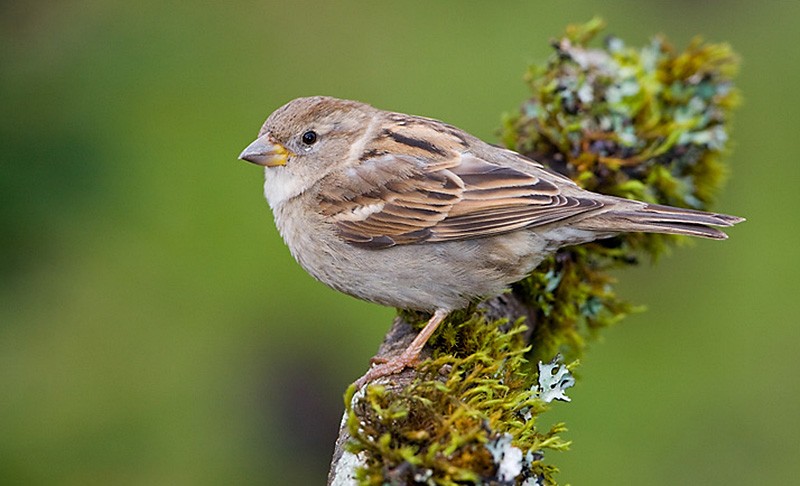
Scientific name: Passer domesticus
Length: 6.25 inches
Weight: .98 ounces
Wingspan: 9.5 inches
Song: “see,chirrup,see,chirrup,see,chirrup”
House Sparrows are small, plump gray and brown birds with conical, finch-like beaks. Males have a gray and rufous head with pale cheeks, and black near their eyes and on their throat.
The rest of their underparts are gray and they have brown, streaked backs with rufous highlights. They also have a white mark in the shoulder of each wing and a grayish rump and tail.
Females are plainer brown and buff, have paler beaks, and buff eyebrows.
House Sparrows feed on seeds, grain, and insects. They are regular visitors to bird feeders and often dominate other smaller species. They also forage on the ground in farmlands, parks, urban areas, and other open situations.
The House Sparrow nests in cavities. When searching for suitable nesting sites, they can kill and remove the eggs and young of smaller species like Eastern Bluebirds.
House Sparrows usually live near people and occur in most of North America, including Minnesota.
Key Identifications:
- Brown and gray sparrow with a bold pattern on its head.
- Feeds on seeds, grain, and insects at feeders and on the ground in urban areas and farmlands.
- Nests in tree cavities, including nest boxes.
- This species is vocal and often makes short chirping calls. Its song is a friendly series of chirping sounds, “see,chirrup,see,chirrup,see,chirrup”.
In many places, the House Sparrow is the common urban sparrow. It occurs in pairs and small groups that forage on sidewalks, in parking lots, farm fields, and other familiar places. This species is one of the very few birds that has evolved to live with people and digest the same grains that we eat.
Mourning Dove
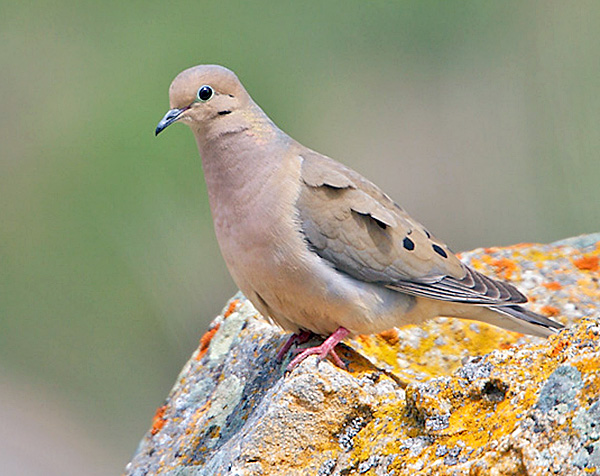
Photograph © Greg Lavaty.
Scientific name: Zenaida macroura
Length: 12 inches
Weight: 4.2 ounces
Wingspan: 18 inches
Song: “hooOOA, hoo, hoo, hoo”
Mourning Doves are medium-sized, grayish-brown doves with long tails. They have small black spots on their wings and a small head with a slender, dark beak.
Males and females also have narrow gray eyerings, a black mark on the face, and pale iridescent gold on the sides of their necks. They look alike except for males having more gray on the head and neck, and more iridescence.
This dove has fairly long wings and swift, direct flight. When flying, it shows black and white in its tail.
The Mourning Dove occurs in woodlands, gardens, on farms, and in urban areas. This common feeder visitor eats seeds and grains. It also forages in open situations, picking food from the ground.
This pleasant dove species can visit a feeder on its own or forage in small flocks. It builds an unkempt stick nest in bushes and trees and is very common throughout the USA, southern Canada, and Mexico.
Key Identifications:
- Plain brown and gray dove with a long, pointed tail.
- Feeds on seeds at feeders and on the ground in open areas.
- Makes a small, messy nest of sticks in trees.
- Sings a sad and owl-like “hooOOA, hoo, hoo, hoo”.
The Mourning Dove is the common garden dove in most of its range. It often visits feeders and its cooing song is commonly mistake for an owl. This species has a short lifespan with many adults only living for a couple of years or less.
Bald Eagle
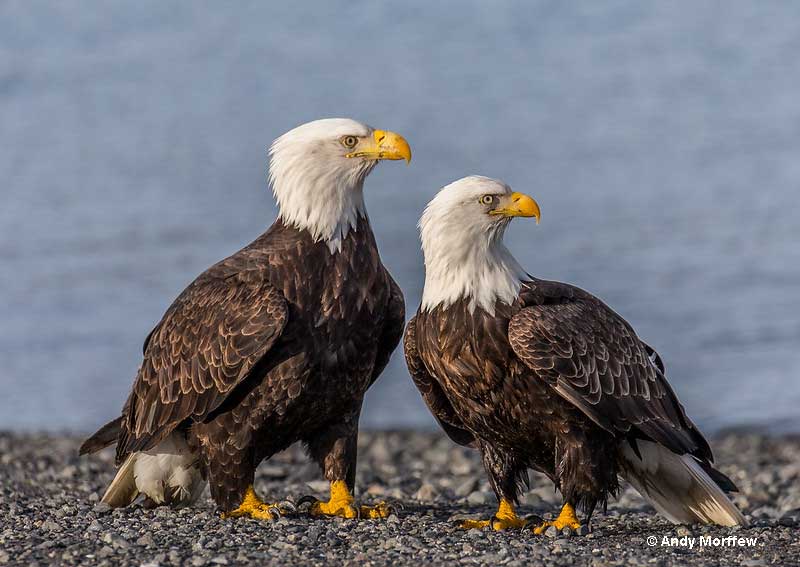
Photograph © Andy Morffew
Scientific name: Haliaeetus leucocephalus
Length: 31 inches
Weight: 9.5 pounds
Wingspan: 80 inches
Song: “pip pipipipip!”
The Bald Eagle is a huge, dark brown raptor with a white head, white tail, and a big yellow beak. Males and females look the same except that females are bigger.
Young birds are dark brown with mottled white and have a mostly dark beak.
In flight, Bald Eagles soar on broad, long wings held flat like a board. They also have deep and slow wing beats.
The Bald Eagle snatches fish from the surface of lakes, rivers, and other shallow wetlands. It also feeds on carrion and occasionally catches small mammals and birds as big as a Canada Goose.
This big raptor builds a big, bulky stick nest high in a tree in or near wetlands. They often use the same nest year after year.
Bald Eagles occur in a variety of wetland habitats in Alaska, Canada, most of the USA (including Minnesota), and some parts of northern Mexico.
Key Identifications:
- Although adult Bald Eagles are unmistakable, young birds can be confused with the Golden Eagle. They are best recognized by their mottled plumage, huge beak, and flat, soaring wings.
- Preys on fish, small mammals, ducks and geese, and also eats carrion.
- Builds a big, bulky nest out of sticks in wetland habitats.
- Bald Eagles make brief, whistled piping calls, “pip pipipipip!”.
The Bald Eagle is a huge raptor with a white head and tail, young birds are dark brown with white mottling. This bird of prey catches fish and aquatic animals and feeds on carrion in many wetland habitats. Persecution and DDT poisoning eliminated Bald Eagles from most of the lower 48 states in the first half of the 20th century.
Since then, thanks to legal protection and reintroduction programs, this majestic bird has come back and thrives in most parts of its range.
Common Grackle
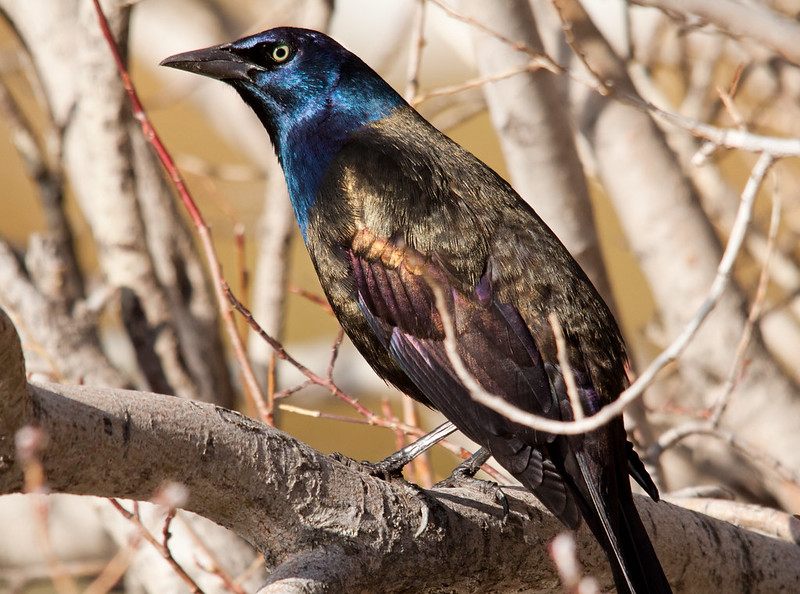
© Shawn McCready
Scientific name: Quiscalus quiscula
Length: 12.5 inches
Weight: 4 ounces
Wingspan: 17 inches
Song: “Sherink!”
The Common Grackle is a jay-sized, glossy black bird with pale eyes and a long, wedge-shaped tail. Depending on lighting, this bird shows metallic purple, blue, green, and bronze highlights.
Males and females look very similar but females have shorter tails and less iridescence. Both sexes also have stout, black beaks, and strong, black legs and feet.
In flight, Common Grackles move up and down as they move through the air. They usually flock together and often forage in farm fields, on lawns, and in other open habitats. These omnivores feed on a variety of items including insects, seeds, grain, small animals, garbage, and the eggs and nestlings of other birds.
Common Grackles build bulky stick nests, usually in conifers in woodlands, parks, near water, and urban areas.
This species can form big flocks in the winter and lives in a variety of semi-open and open habitats in eastern Canada and the eastern USA.
Key Identifications:
- Fairly large, black bird with glossy purple, greenish, bronze, or dark blue highlights. It also has pale eyes and a long, wedge-shaped tail.
- Forages for insects, seeds, and other food on the ground in a variety of open habitats.
- Constructs a bulky cup nest in a conifer.
- Common Grackles are vocal birds. They frequently give raspy, metallic calls, “Sherink!”, and “kek” calls.
The Common Grackle is a common, glossy black bird with pale eyes. It usually occurs in flocks in open and park-like habitats. This species occasionally nests in odd places, including occupied nests of Great Blue Herons and Ospreys!
Gray Catbird
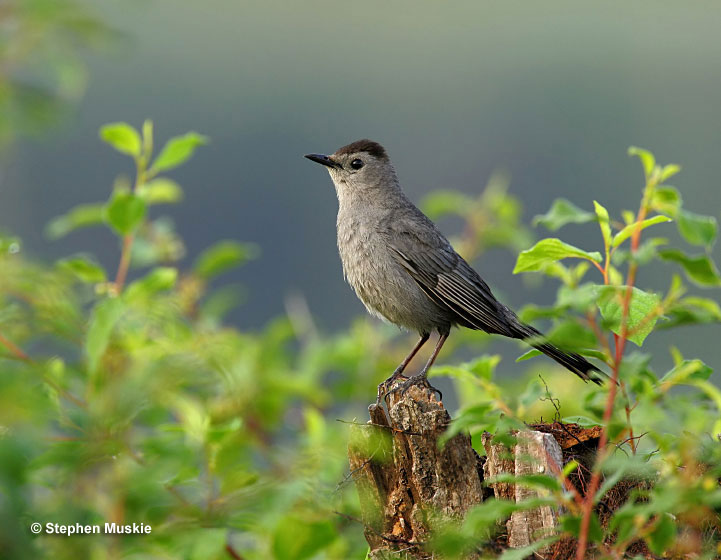
Scientific name: Dumatella carolinensis
Length: 8.5 inches
Weight: 1.3 ounces
Wingspan: 11 inches
Song: “rheah!”
The Gray Catbird is a slender, gray songbird with a black cap, and chestnut under its tail. Both sexes look alike and have beady, black eyes on a gray face, a longish tail, and a smallish, black beak.
This reclusive bird feeds on insects and berries in thickets and second growth. It forages by moving through dense vegetation and picking food items from leaves and twigs.
Gray Catbirds make bulky, open cup nests constructed with grass, strips of vegetation, and hair. They build their nests in shrubs, bushes, and small trees.
The Gray Catbird is often heard before it is seen, and loves to skulk in low thick vegetation. This migrant species spends summers in southern Canada, and in much of the eastern and northern USA. In fall, it migrates to coastal areas in the eastern and southern USA, and Florida south to northern South America.
Key Identifications:
- Small to medium-sized, slender gray bird with a black cap and chestnut under the tail.
- Feeds on insects and berries in low, dense vegetation.
- Builds a bulky cup nest in small trees and bushes.
- The Gray Catbird is quite vocal and often makes a cat-like mewing call, “rheah!”. It also has a melodious, complex song made of jumbled, chattering sounds and phrases.
Gray Catbirds are slender gray songbirds with a black cap and chestnut under the tail. Pairs forage for bugs and berries in dense second growth. Although they don’t mimic as many bird species as their mockingbird relatives, Gray Catbird songs include the sounds of some birds, frogs, and other noises.
Ring-billed Gull
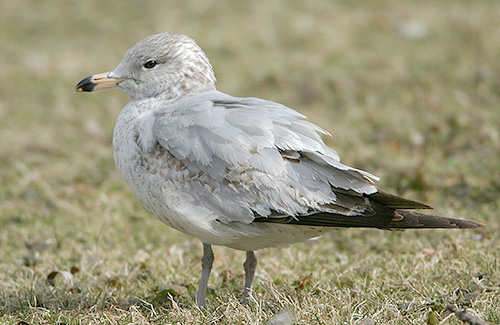
2nd year, winter. Photograph © Sam Crowe.
Scientific name: Larus delawarensis
Length: 17.5 inches
Weight: 1.1 pound
Wingspan: 48 inches
Song: “KLEE..KLEEE..kleeya,kleeya,kleeya”
The Ring-billed Gull is a medium-sized pale gray and white gull with a black ring around its yellowish beak. Males and females look the same and have yellowish legs and feet, pale eyes, and black wing tips with a few white spots.
These gulls have direct, fairly quick flight with leisurely wing beats. Young birds have pink and black bills, a white tail with a black tip, and mottled black and gray wings.
Ring-billed Gulls are scavengers and opportunists that feed on carrion, fish, worms, small animals, grain, and other food items. They usually occur in flocks that roam lakes, rivers, urban areas, and other habitats in search of feeding opportunities.
These gulls breed in colonies, often on islands, and make a shallow stick nest on the ground.
This gull species occurs not only in Minnesota, but also in many parts of Canada and the USA south to Central America.
Key Identifications:
- Medium-sized pale gray and white gull with a black ring on its bill and yellow legs and feet. Juveniles have pink and black beaks.
- Forages for fish, carrion, and many other food items in wetlands and open habitats.
- Nests on the ground, in colonies.
- Ring-billed Gulls often call. In flight, they often make a high-pitched “kleea” sound. On the ground, displaying birds make a loud, laughing, “KLEE..KLEEE..kleeya,kleeya,kleeya”.
Ring-billed Gulls are pale gray and white, medium-sized gulls with a black ring around their beaks and yellow legs and feet. They are well adapted to living with people and occur around lakes, rivers, and other wetlands, parking lots, garbage dumps, and other places. This gull species is a bold bird that can snatch bits of food from unguarded picnic tables.
European Starling
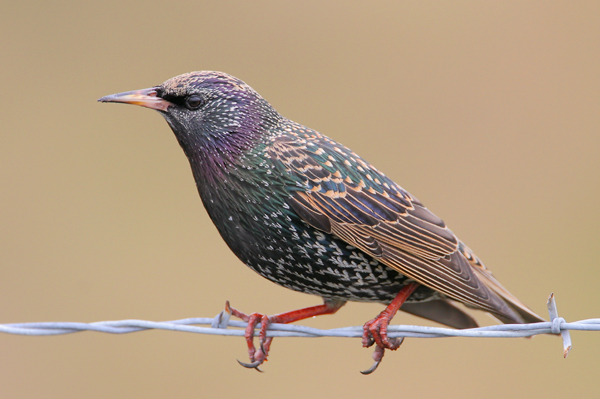
Photograph © Greg Lavaty.
Scientific name: Sturnus vulgaris
Length: 8.5 inches
Weight: 2.9 ounces
Wingspan: 16 inches
Song: “tiktiktitZHREEree..tiktiktik..ZHREE”
European Starlings are plump, short-tailed birds with long sharp beaks and longish, pointed wings. In summer, they have yellow beaks, glossy black plumage with purple and green highlights, and some small white spots.
Males and females are similar but males have less spotting and glossier plumage. In winter, they have black beaks, white spots, and more reddish colors in their wings.
Young starlings are shaped like adults but are grayish birds with a dark beak and a pale throat.
This species feeds on a variety of insects, fruit, and seeds. They can dominate bird feeders and are common species in urban areas, parks, farmlands, and other open habitats.
This European Starling builds a soft cup nest in a tree cavity, nest box, or suitable cavity in other structures.
European Starlings flock with each other and blackbird species, especially during the winter. They live across a large part of Canada and the USA.
Key Identifications:
- Rotund, short-tailed bird with a long, sharp beak, and pointed wings. Glossy black with some spotting in the summer and blackish with heavy white spotting and streaking in the winter.
- Feeds on seeds, fruit, and insects. Visits feeders and forages on the ground in flocks.
- Builds a soft cup nest in nest boxes and other cavities.
- The European Starling makes a wide variety of mechanical and whistled sounds. They also mimic other birds and sounds in their environment. They sing long, jumbled mechanical-sounding songs, “tiktiktitZHREEree..tiktiktik..ZHREE”.
European Starlings are rounded, blackish birds with long, sharp beaks and short tails. They live in towns, cities, parks, on farms, and in other open habitats. This species forms large flocks called, “murmurations” that move in coordinated patterns.
Wood Duck
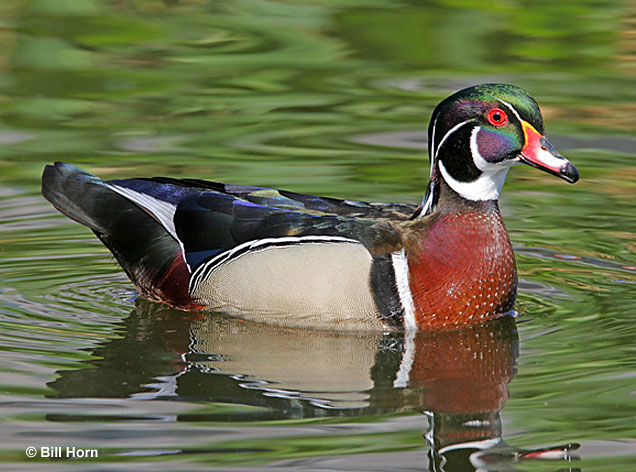
Scientific name: Aix sponsa
Length: 18.5 inches
Weight: 1.3 pounds
Wingspan: 30 inches
Song: “woo-eek, woo-eek, woo-eek!”
The Wood Duck is a smallish, slender, colorful duck with an odd, square-shaped or rounded head. Males have a dark green, mane-like crest, a bright red beak, and a black and white pattern on their face and throat.
They also have yellowish flanks, a chestnut neck, breast, and undertail, and dark, glossy green back and wings. Female Wood Ducks are mostly grayish-brown, have small pale markings below, and a big white mark around their eyes.
In its quick flight, this duck shows long, mostly dark wings, a white belly, and a longish tail.
Wood Ducks eat insects, seeds, fruits, and acorns. They forage by rapidly picking food from the surface of shallow water and pick up acorns and grain from the ground.
These beautiful ducks nest in tree cavities in wooded swamps, and also use big nest boxes.
They frequent wooded swamps and shrubby wetlands in parts of southern Canada, the eastern USA, and parts of the western USA.
Key Identifications:
- Smallish, slender duck with a rounded or square-shaped head, and white belly. Males are colorful, unmistakable ducks with red beaks and a dark green mane. Females are grayish brown and have a big white mark around their eyes.
- Picks insects, seeds, and other food items from shallow water and the ground.
- Nests in tree cavities and big nest boxes.
- Quite vocal, makes loud, odd, squeaking calls, “woo-eek, woo-eek, woo-eek!”. Males make similar but higher-pitched sounds.
Wood Ducks are smallish, slender waterfowl with short beaks, square-shaped heads, and longish tails. They only live in wooded wetland areas and use tree cavities for nesting. These arboreal sucks have claws on their feet to help them grip and perch in tree branches.
Common Yellowthroat
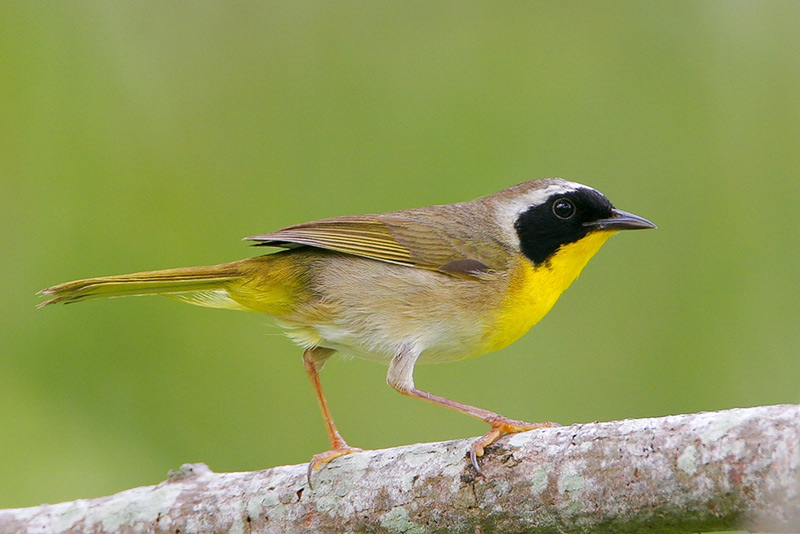
Photograph © Greg Lavaty.
Scientific name: Geothlypis trichas
Length: 5 inches
Weight: .35 ounces
Wingspan: 6.75 inches
Song: “witchey..witchety..witchety!”
The Common Yellowthroat is a small, olive-brown warbler with a yellow throat and undertail. Males have a black mask with a pale border on part of it.
Females are plainer and lack the black mask. Instead, they have a hint of a pale eyering. Both sexes have pale brown flanks, rounded wings, and a rounded tail.
Common Yellowthroats feed on insects and spiders that they find in low, wet, dense vegetation. They forage by picking food items from leaves and stems.
The Common Yellowthroat makes a loose and bulky, well-hidden cup nest out of grass and other plant matter. The female builds the nest on or close to the ground in dense grassy or marshy vegetation.
This warbler species frequents low, wet tangles, the grassy edges of creeks and rivers, and other marshy vegetation. It is a summer resident over a large part of Canada and the USA. This species also winters in California and the southeastern USA.
Key Identifications:
- Small warbler with a yellow throat and undertail. Males have black masks, females are plain olive-brown and have a hint of an eyering.
- Forages for insects in low, wet, dense vegetation.
- Makes a loose, bulky, well-hidden cup nest on or near the ground.
- Males sing a friendly, warbled, “witchey..witchety..witchety!”. Both sexes also make a short, “jerrt!” call.
The Common Yellowthroat is a small warbler with a yellow throat and black mask, or a yellowish throat and plain olive-brown upperparts. It lives in low, dense, wet vegetation in the summer and migrates south for the winter. In some places, this warbler is known as “The Yellow Bandit”.
Cedar Waxwing
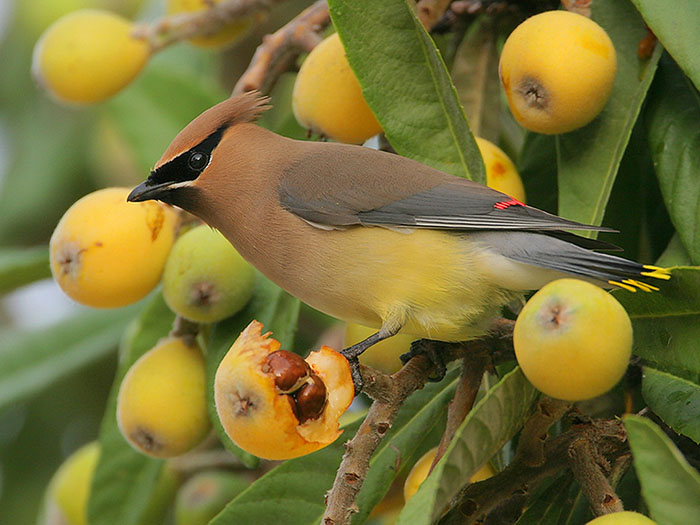
Scientific name: Bombycilla cedrorum
Length: 7.25 inches
Weight: 1.1 ounces
Wingspan: 12 inches
Song: “sree…zree!”
The Cedar Waxwing is a thrush-sized, crested bird with a black mask, black throat, and sleek, pale brown, gray, and yellow plumage. Both sexes look similar and have bright yellow on the tip of their tail, and a pale yellow belly.
Young birds are grayish-brown with some thick streaks on white underparts. Adult Cedar Waxwings also have a few small red dots on their wings, and have a white undertail.
This species feeds on insects and small fruits. In summer, waxwings often sally into the air to catch bugs in flight. However, they mostly feed on berries and forage for them in large flocks, especially in the winter.
The Cedar Waxwing constructs a bulky, open cup nest out of moss, flowers, bark, other bits of plants, and other materials. It builds its nest in an isolated tree or bush.
Cedar Waxwings breed in a large area of Canada and occur in the northern half of the USA.
Key Identifications:
- Sleek, pale brown and gray crested bird with a black mask, black throat, and a bright yellow tip on its tail.
- Catches insects in flight and visits fruiting and trees and bushes to feed on berries.
- Uses bark and other materials to make an open cup nest in an isolated tree or bush.
- Cedar Waxwings are very vocal and often make a soft, whispering call, “sree…zree!”.
The Cedar Waxwing is a thrush-sized, pale brown and gray bird with a crest, black throat, and black mask. They usually occur in groups that flock to fruiting trees. This frugivorous species can become intoxicated after eating too many fermented berries!
Northern Flicker
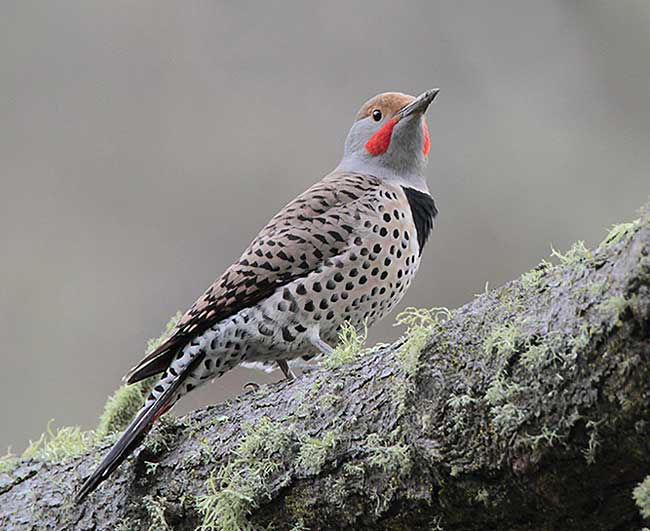
Scientific name: Colaptes auratus
Length: 12.5 inches
Weight: 4.6 ounces
Wingspan: 20 inches
Song: “kick,kick,kik,kik,kik.kik.kik.kik.kik.kik.kik.kik!”
Northern Flickers are fairly large, tan and gray woodpeckers with barring on their backs. They have a black mark on their breast, black spotting below, and a dark, stout beak.
Males in the east have a tawny throat and face with a black moustache and small red spot on the back of their heads. Males in the west have mostly gray heads with a red moustache.
Female Northern Flickers look like males but lack the moustache mark.
In bounding flight, they have white rumps and flash color on their underwings. This is bright yellow in eastern birds and reddish in flickers west of the Rocky Mountains.
This woodpecker eats many ants and other insects that it catches on the ground. It forages by flying to the ground, locating anthills, and lapping them up with its long tongue.
Northern Flickers nest in tree cavities and live in wooded and open habitats in Canada, the USA, and Mexico.
Key Identifications:
- Tan and gray woodpecker with black barring above, black marks below, and a bright, white rump.
- Forages for ants and other insects on the ground.
- Nests in tree cavities.
- A vocal woodpecker, the Northern Flicker often gives loud, “flicka,flicka,flicka” calls, and another loud, single note that sounds like, “Keer!” They also have a long, laughing vocalization of repeated notes, “kick,kick,kik,kik,kik.kik.kik.kik.kik.kik.kik.kik!”.
Northern Flickers are fairly big, tan woodpeckers with gray highlights, a white rump, and black markings. They mostly forage for ants on the ground in open and wooded areas. The red-shafted Northern Flickers in the west used to be considered a separate species from the yellow-shafted flickers of the east. At present, they are considered to be one species because they frequently hybridize with each other.
Red-breasted Nuthatch
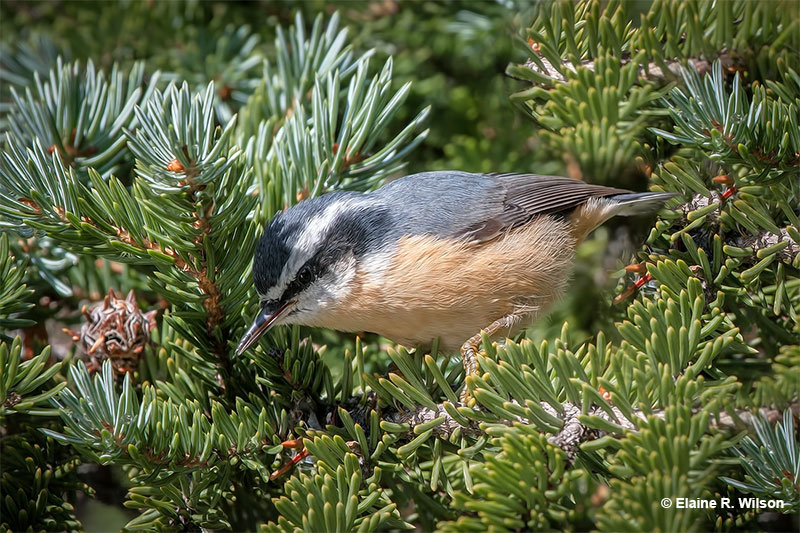
© Elaine R. Wilson
Scientific name: Sitta canadensis
Length: 4.5 inches
Weight: .35 ounces
Wingspan: 8.5 inches
Song: “yeank, yeank, yeank”
The Red-breasted Nuthatch is a small, warbler-sized bird with a dark gray, straight or slightly upturned beak, gray upperparts, and reddish-orange underparts. It also has a black cap, a white face with a narrow black mask, and black and white in its short tail.
Males and females are similar except that females are paler and have a gray cap.
Red-breasted Nuthatches eat insects during the summer and conifer seeds in the winter. These small, animated birds forage by creeping down coniferous tree trunks and on branches. They use their bills to probe bark and pick out insects and seeds.
This species excavates a tree cavity and makes an open nest of bark and other vegetation.
The Red-breasted Nuthatch lives in coniferous and mixed forests in southern Alaska, Canada, and the western and northern USA. They also breed in the Appalachians and can be seen in most of the USA in winter.
Key Identifications:
- Small, short-tailed bird with a narrow white eyebrow, black mask, gray upperparts, and reddish-orange underparts.
- Creeps along tree trunks and branches to forage for insects and conifer seeds.
- Nests in tree cavities.
- The distinctive nasal call of the Red-breasted Nuthatch, “yeank, yeank, yeank”, is a good way to find this bird.
The Red-breasted Nuthatch is a small, short-tailed bird with black and white on its head, gray upperparts, and reddish-orange underparts. It usually occurs alone and lives in coniferous woods and trees. To protect its nest, this species puts sticky pine resin around the border of its nesting hole.
Trumpeter Swan
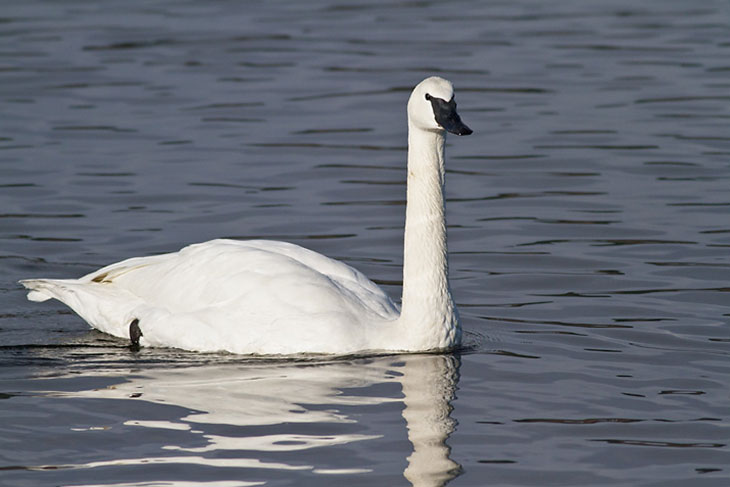
Scientific name: Cygnus buccinator
Length: 60 inches
Weight: 23 pounds
Wingspan: 80 inches
Song: “henk henk honk”
The Trumpeter Swan is a massive white bird with a long neck and a black, straight, duck-like beak. With a close look, we can see a reddish line on the cutting edge of its beak.
Males and females look the same but young birds have some gray in their plumage and a pale mark on their beak. In flight, these huge birds move their big, broad wings with deep, steady flaps.
Trumpeter Swans eat roots, tubers, aquatic plants, grain, and the occasional fish. They forage by dipping their head below the surface of shallow water.
This big waterfowl species uses aquatic vegetation to construct a mound nest in freshwater marsh habitats.
The Trumpeter Swan breeds in a variety of freshwater wetlands in Alaska, western and southern Canada, and at scattered sites in the northern USA. Many birds migrate to coastal British Columbia, and sites in the central and eastern USA.
Key Identifications:
- Huge white swan with a long neck, and a straight black beak.
- Dips its head below the surface of shallow water to feed on tubers, roots and aquatic vegetation.
- Makes a mound nest in wetlands, quite far from shore.
- This swan species makes soft calls that sound almost like a toy horn; “henk henk honk”.
Trumpeter Swans are huge white birds with long necks and large black beaks. They often occur in small groups that forage for tubers, grain, and other items in lakes, rivers, and marshes. In the lower 48 states, by 1935, the formerly common Trumpeter Swan had been nearly hunted to extinction. Thanks to conservation programs, at present times, thousands of these majestic swans live in their former range.
Chipping Sparrow
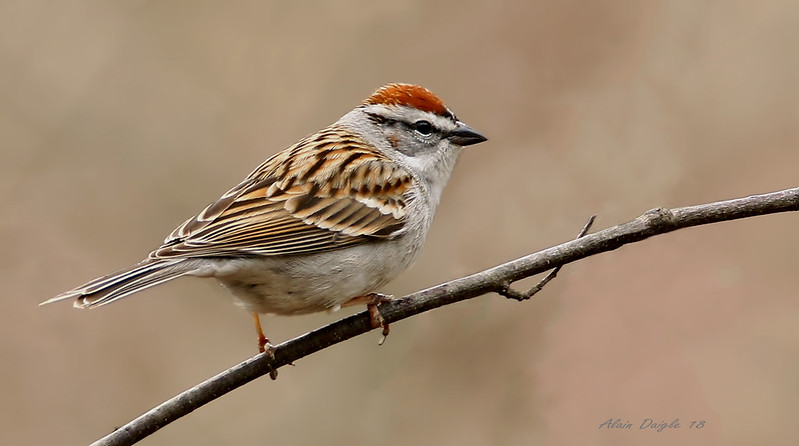
© Alain Daigle
Scientific name: Spizella passerina
Length: 4.7 to 5.9 inches
Weight: 0.4 to 0.6 ounces
Wingspan: 8.3 inches
Song: “Zeeeee” or “see-see-see-see”
In the summer, Chipping Sparrows look crisp and clean. They have pale faces, frosty underparts, black lines through the eye, and bright rusty crowns. In the winter, Chipping Sparrows are duller. They have darkly streaked upper parts and are buffy brown overall. The black lines through the eyes are still visible, and the cap is a paler reddish brown.
Chipping Sparrows inhabit woodlands, parks, grassy forests, essentially any areas that have trees. They tend to gravitate toward evergreens when they’re available. However, they’ll also use eucalyptus, aspen, oak, birch, and pecan trees.
These sparrows primarily consume seeds of a wide variety of herbs and grasses. During their breeding season, they’ll hunt for insects that are rich in protein. Additionally, Chipping Sparrows will occasionally consume small fruits like cherries.
Key Identifications:
- In the summer, Chipping Sparrows have pale faces, frosty underparts, black lines through the eye, and bright rusty crowns. In the winter, Chipping Sparrows have darkly streaked upper parts and are buffy brown overall.
- These birds are smaller than a Song Sparrow.
- Chipping Sparrows have relatively long tails and medium-sized bills.
- Chipping Sparrows can be found around trees, and they favor evergreen trees.
Chipping Sparrows are common in Canada, the United States, Mexico, and Central America (being one of the most common birds of Minnesota). Their bright rufous cap makes adults relatively easy to identify and provides a splash of color. You can attract these birds to bird feeders by offering white millet and mealworms. You’re best bet, though, is to sprinkle the food on the ground, directly below the feeders.
House Wren
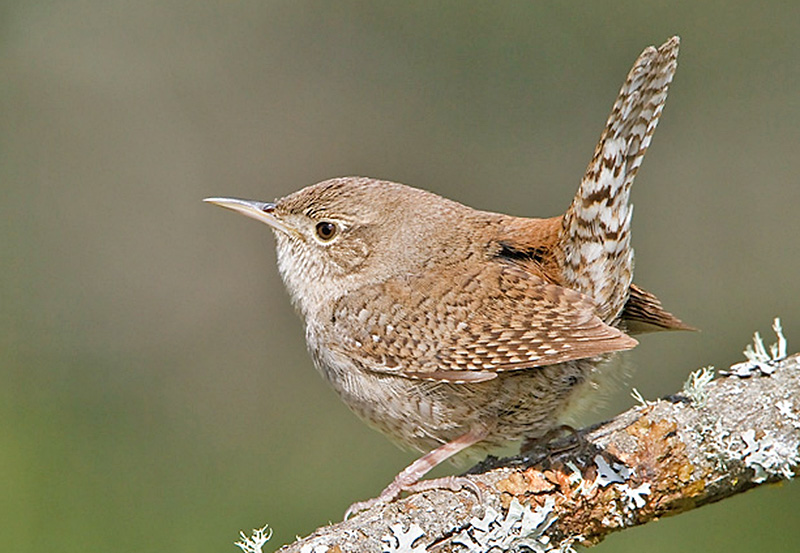
Photograph © Glenn Bartley.
Scientific name: Troglodytes aedon
Length: 4.75 inches
Weight: .39 ounces
Wingspan: 6 inches
Song: “sipsipsip twee tereesupsupsup”
The House Wren is a small plain, grayish-brown bird with a thin, sharp, slightly downcurved beak. Males and females look alike, have pale throats, and dark barring on their wings, tail, and under the tail.
They feed on insects, spiders, and other small creatures on logs, in thickets, and in foliage. These inquisitive little birds search for food in low vegetation, rocks, and around structures on and near the ground.
These wrens also find food in dead leaves and other tangled vegetation. They aren’t shy about picking bugs from windows or briefly entering houses. They often hold their tails cocked up.
The House Wren nests in tree cavities and nest boxes. Inside the cavity, it makes a platform out of sticks and constructs a small cup nest on top.
House Wrens occur alone or in pairs in gardens, forest edges, and open, wooded areas in much of Canada, the USA, and Central and South America.
Key Identifications:
- Small, plain grayish-brown bird with a sharp, slightly decurved beak and a pale throat.
- Forages for insects and other small creatures on and near the ground.
- Nests in tree cavities and nest boxes.
- The House Wren is a vocal bird that often makes short raspy calls. They also frequently sing a bright and bubbly song, “sipsipsip twee tereesupsupsup”.
The House Wren is a small, plain gray and brown bird often seen in gardens, parks, and around houses. Pairs forage on and near the ground, and frequently call and sing. House Wrens sometimes add spider egg sacs to their nests. When the spiders hatch, they help control mites and other small insects inside the nest.
Pileated Woodpecker
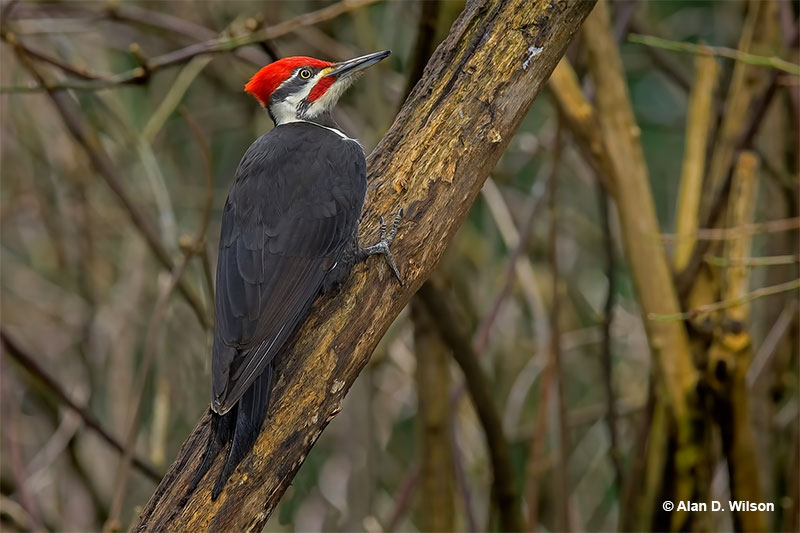
Scientific name: Dryocopus pileatus
Length: 16.5 inches
Weight: 10 ounces
Wingspan: 29 inches
Song: “kek,kek,kek,kek,kek,kek!”
The Pileated Woodpecker is a big, crow-sized black woodpecker with a pointed, red crest, and a black and white face. Males have red extending from the bill to the back of the crest and a red “moustache” mark on their face. Females only have red on the top of the crest.
Both sexes have white on each side of their necks, and a white patch on the front part of each wing. They also have a longish, pointed black tail, and, in flight, show a lot of white on their underwings.
Pileated Woodpeckers are often seen in undulating and direct flight between forest patches. In their search for carpenter ants and insects, they use their strong beaks to make rectangular holes in trees and stumps.
This species nests in tree cavities, usually high above the ground. It lives in mature woodlands in Canada, much of the eastern USA, and parts of the Pacific Northwest.
Key Identifications:
- Big, black, crested woodpecker with some red on its head, and black and white on its face, neck, and underwings.
- Pecks into wood to feeds on ants and other insects.
- Nests in tree cavities in mature forests.
- The Pileated Woodpecker makes a loud, repetitive laughing sound, “kek,kek,kek,kek,kek,kek!”.
Pileated Woodpeckers are big, mostly black woodpeckers with red on their crest and black and white on their face. They peck into wood to forage for ants and other insects and occur in mature forests. This species makes distinctive, large rectangular holes.
White-throated Sparrow
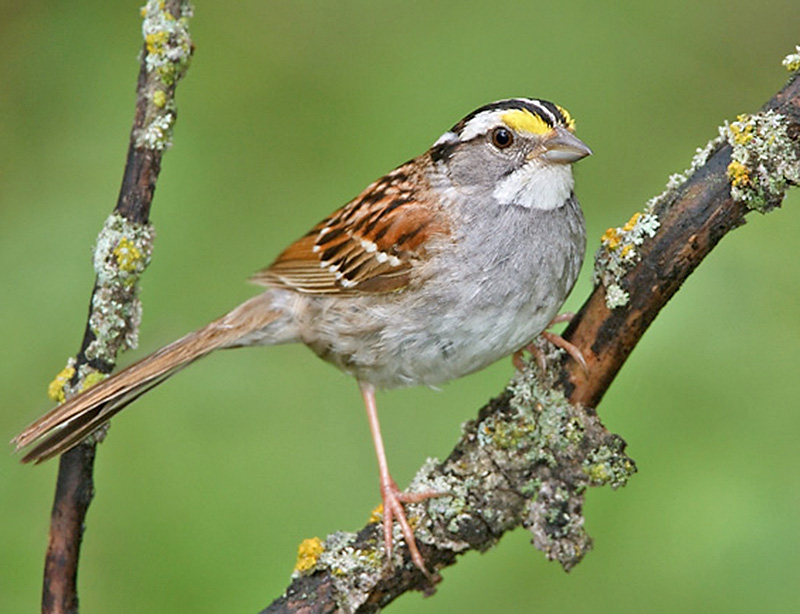
White-throated Sparrow (Zonotrichia albicollis) perched on a branch in Manitoba, Canada.
Scientific name: Zonotrichia albicollis
Length: 6.75 inches
Weight: .91 ounces
Wingspan: 9 inches
Song: “Ohhh Canada Canada Canada”
The White-throated Sparrow is a chunky, gray and brown sparrow with a white throat, and black and white stripes on its head. It has dark streaks on its back, a gray rump, and a bit of yellow in front of its eyes.
Males and females look the same and have reddish-brown wings with two white wing bars. Young White-throated Sparrows and some adults are duller brown with tan stripes on their heads and a dingy white throat.
White-throated Sparrows forage for seeds and insects on the ground and also eat fruits in short trees and bushes. They reveal hidden food items by using their feet to scratch and kick away leaves.
This sparrow breeds in northern forests and builds a cup nest with grass and twigs. They construct the nest at the edge of forest, on or close to the ground, in dense vegetation.
These sparrows usually occur in flocks and winter in the eastern and southwestern USA and parts of California.
Key Identifications:
- Large sparrow with a white throat and bold black and white or tan stripes on its head.
- Scratches leaves on the ground to find seeds and insects. They also eat berries.
- Makes a cup nest of grass, bark, and twigs, on the ground, under dense vegetation.
- Flocks of White-throated Sparrows often make sharp “tink” calls. They also sing a clear, whistled song, “Ohhh Canada Canada Canada” or, “Ohhh, Cana, Cana, Cana”.
White-throated Sparrows are hefty gray and brown sparrow species with white throats, and black and white or tan stripes on their head. The yellow pigment in the patches in front of their eyes comes from eating colorful berries during fall and winter.
Barn Swallow
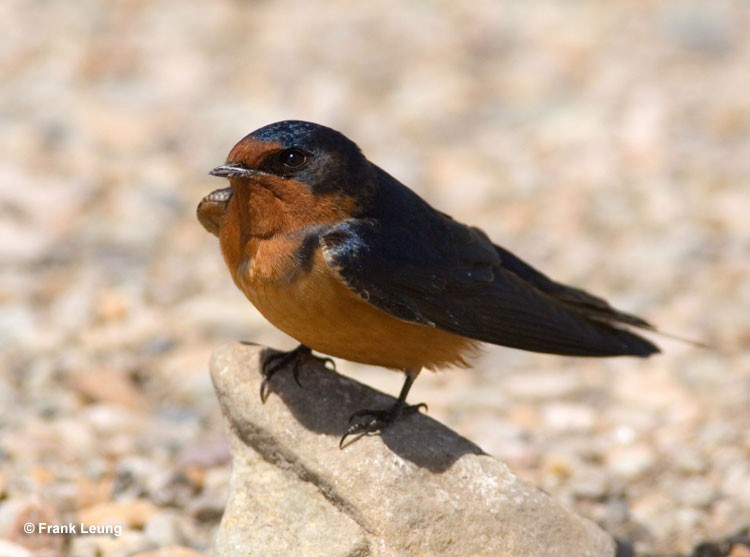
Scientific name: Hirundo rustica
Length: 6.75 inches
Weight: .67 ounces
Wingspan: 15 inches
Song: “chipchipfitfibitchipfibitfwip”
Barn Swallows are small to medium-sized swallows with long forked tails. They are dark, steel-blue above, peach-orange below, and have rich chestnut on the throat and above their bill. It also has some white in its tail.
Males and females look similar but females are paler and have shorter tails. Young birds are like females but their tails are even shorter.
The Barn Swallow is one of the most common birds in Minnesota. It has long, pointed wings and fast flight. When flying, they often flap their wings a few times between brief glides.
Barn Swallows live in farming areas, meadows, parks, and other open habitats. They feed on insects as they fly through the air. Although they can fly high overhead, Barn Swallows often swoop low over the ground.
This handsome swallow builds a mud nest on the wall of a barn, bridge, or other structure. Barn Swallows live in large areas of Canada, the USA, Mexico, Europe, and Asia.
Key Identifications:
- Beautiful dark blue and orange swallow with a long, forked tail.
- Forages for insects in flight over fields and other open habitats.
- Constructs a cup nest out of mud in barns and other structures.
- Often makes brief “fwip” calls in flight, and has a long, complex song, “chipchipfitfibitchipfibitfwip”.
The Barn Swallow is a common and easily species in most of its range, and the only swallow with a long, elegant tail. In summer, it is often seen flying low over the ground in open habitats. Barn Swallows are long distance migrants and some fly 5,000 miles, all the way to Argentina!
Great Blue Heron
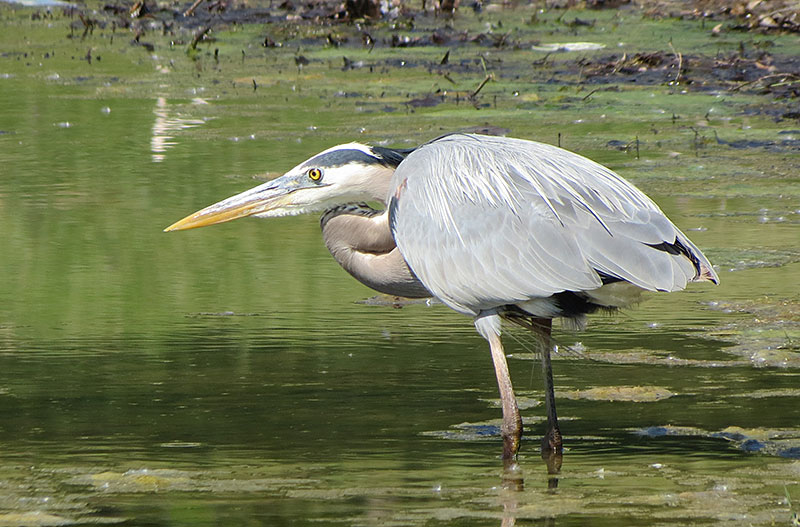
Great Blue Heron
Scientific name: Ardea herodias
Length: 46 inches
Weight: 5.3 pounds
Wingspan: 72 inches
Song: “Grunk! Grunk!”
The Great Blue Heron is a large, gray, and pale brown heron with a long neck and legs. They have strong, yellowish beaks, black and white heads with a wispy black crest, and rufous thighs.
Both sexes are alike and have pale bellies and black flanks. Juveniles have streaked underparts.
In flight, they make slow, deep flaps with long, broad gray and black wings. In Southern Florida and the Caribbean, Great Blue Herons are all white and sometimes considered a separate species – the Great White Heron.
These powerful herons feed on fish and small animals such as rats, snakes, and birds. They wade in and near water, wait, and then quickly catch prey with their sharp beaks.
We find these impressive birds in and near a wide variety of wetlands in large parts of Canada, the USA, and the Caribbean, even in Minnesota.
Key Identifications:
- Huge gray and pale brown wading bird with a thick, yellowish beak and a wispy crest. In southern Florida, it is all white but still has a crest and a strong yellowish beak.
- Stalks and preys on fish and small animals.
- Builds messy stick nests and breeds in colonies.
- Great Blue Herons aren’t all that vocal. When taking flight they make a croaking sound, “Grunk! Grunk!“.
The Great Blue Heron occurs on rivers, lakes, and many other wetlands. It stands still for long periods of time while waiting for prey to come within range of its sharp beak but is also, often seen in flight. In some parts of Florida, Great Blue Herons have a gray and brown body and a white neck and head. These birds are known as, “Wurdemann’s Heron”.
Birds of Minnesota – Frequently Asked Questions
How many types of birds are there in Minnesota?
There are 443 types of birds in Minnesota. The official Minnesota bird list has 443 species.
What is the most common bird in Minnesota?
The most common bird in Minnesota is the Black-capped Chickadee. There are more sightings of this cute little bird on eBird than any other species in Minnesota.
What is the most common sparrow in Minnesota?
The most common sparrow in Minnesota is the Song Sparrow. There are more sightings of this sparrow species on the eBird platform than any other sparrow in Minnesota.
What is the fastest bird in Minnesota?
The fastest bird in Minnesota is the Peregrine Falcon. This bird of prey is the fastest bird in the world. It can reach speeds of 200 miles per hour when diving after prey.
Read next: Hawks in Minnesota | Owls in Minnesota | Ducks in Minnesota

